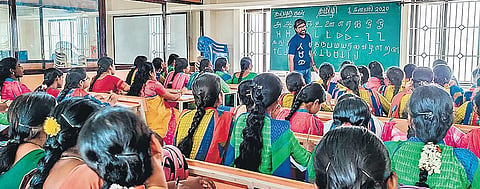

KARUR: A school in Karur is opening a doorway to ancient wisdom by teaching its students Tamizhi, one of the oldest scripts of the only surviving classical language in the country — Tamil. Tamizhi or Tamil Brahmi is an early script form of Tamil, dating to the 3rd century BCE. It was used in inscriptions seen on temples, stone beds, caves, entrances of ancient monuments, coins, seals, earthenware, palaces, palm leaf manuscripts, and more. Scholars and researchers say that there have been 19 notable changes in the Tamizhi script as it evolved, over centuries, into modern Tamil.
Dr C Ramasubramaniam, national coordinator of the Students and Youth for Thirukkural (SYT) Welfare Movement, and senior principal of Bharani Park Institutions in Karur district has been on a mission to revive the 2,500-year-old Tamizhi script. Owing to his efforts in organising camps and workshops, over 6,000 students and teachers across Tamil Nadu have learnt the script form. Still, he has some lofty targets, aiming to teach 25,000 students the script by April 14, Tamil New Year, and 1 lakh students by the end of 2021.
“It all started when the Archaeology club at our school had arranged for a special exhibition on the Keezhadi excavations last year,” Ramasubramaniam recalled. “At the event, the organisers wrote vistors’ names on their admit cards in the Tamizhi script format. Everyone was amused to see their names in a different form of their mother tongue. This created an interest in me,” he said.
Intrigued, he decided to learn the script. “Bhuvaneshwari, a Tamil activist approached our school to teach Tamizhi to a set of interested students. I learned the script from her,” he said. “After learning it, I was able to read the letters written in inscriptions in temples, which made me feel more connected to our history. So I decided to share that feeling with the rest of the world,” he said. He started by teaching 300 teachers at his school for a week. Once they picked up the script, they started teaching the students. “5,000 students of our school are now learning. Close to 1,000 of them can write and read the script without any difficulties,” he said, adding that an adult could learn the whole script form in just three hours.
Next, he became part of a group of 28 — teachers, students — to recreate the Thirukkural in Tamizhi and it make a digital book of the effort. “This draft book of ours has been praised by many, including former MP Tarun Vijay, Tamil Nadu ministers, district collector Anbalagan, Tamil activists and scholars,” he said. The book will soon be launched in New Delhi and TN soon. Then, the group plans to recreate all classical Tamil literary works in Tamizhi script. As word of his efforts spread, schools and colleges from across the state have asked Ramasubramaniam to teach the script to their teachers and students.
Bhuvaneswari, who taught Ramasubramaniam the script, said that 700 Tamil enthusiasts from Aram Kuzhu have also been teaching the Tamizhi script in schools across the state. “It was Senthi Natrajan, a renowned inscription researcher who asked us to take Tamizhi among the school students in Tamil Nadu. We learned the Tamizhi, Vattezhuthukal and the Grantha script forms of Tamil from him. We chose Tamizhi for the students because it was the oldest and was easiest to learn. And also most of the Tamizhi inscription stones are found on the rural and remote villages. Many, unaware about those stones, are using them as washing stones, pillars and for the stairs. So if students learn about it, they’ll identify them and bring out the real hidden treasures,” she said, adding that the intention is to create an interest for our own history among next generations.
Mahalakshmi, an English literature student at a private college who learnt the script through a workshop, agreed that it made her feel more connected with her culture and history. “When I read an inscription in Tamizhi format, it gives me goosebumps,” she said. Meanwhile, Ramasubramaniam has decided to start learning the Vattezhuthu script form of Tamil by the start of next year.
“Then, the people of Tamil Nadu will become the only people in the world to know all three script forms of a single classical language,” he said. Palaniappan, a Tamil activist, said these efforts gave him hope Tamil would survive for centuries to come. “Also, youth won’t vandalize ancient inscriptions. They will try and read what is written,” he noted.